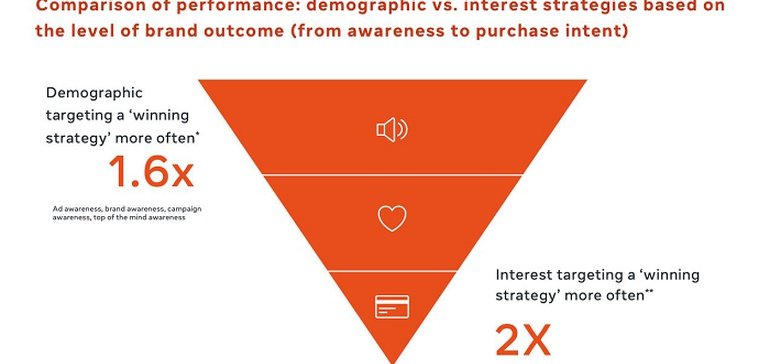This is a somewhat convenient study finding from Meta, given the more recent restrictions in audience data gathering as a result of Apple’s ATT update.
Today, Meta has published a new report which looks at the performance impacts of broad, demographic-based targeting for CPG ad campaigns, versus interest targeting strategies, which are more honed in on specific audience aspects, but are also inherently more restrictive as a result.
Which one performs better, then, comes down to how interest targeting is applied, and according to Meta, ‘overnarrowing’ your audience through interest targeting can significantly impede performance in campaigns.
Which, given that you now have fewer data options for such, seems like a good result for Meta’s ad options, right?
The actual analysis is a bit more nuanced than this – in order to assess the performance of broad versus narrow ad targeting, Meta analyzed 50 CPG campaigns in EMEA, measured via Facebook Brand Lift, which provides an assessment measure of relative ad performance.
As explained by Meta:
“The analysis found that in approximately half of the campaigns, the selected interest audiences were too narrow and therefore significantly restricted reach compared to the demographic audience. In this case (when selected interest audiences were too narrow), demographic audiences delivered almost double the reach (+99%) over interest audiences for equal budget.”
So demographic targeting – not impacted by ATT – is better. That’s a thumbs up for Meta’s business interests.
In digging a little deeper, the results are actually fairly logical – when utilizing interest-based targeting, as opposed to broader reach through demographics, the results need to be significantly better in order to justify the more limited reach (i.e. you’re reaching fewer people, but if they spend more overall, then the reduced brand awareness benefits are offset by stronger direct response).
Meta’s data shows that this isn’t, in general, the case:
So while focusing on more specific audiences can deliver better results, on a person-by-person basis, broader reach actually delivered better outcomes the majority of the time, because reaching more people, via more generic targeting, broadened brand messaging, and helped reach even more interested users.
Of course, a lot of that comes down to how well you know your audience, and how well you actually utilize interest targeting. For those with very refined interest-targeting processes, they can actually drive significantly better campaign results through more specific focus.
As you can see in this chart, interest targeting does perform better for lower-funnel campaigns – so while reaching a broader audience is better for brand awareness, if you have a more specific goal in mind, and more audience insight, focusing on more detailed interest categories can improve direct response.
This makes sense. In the early stages, you need to reach as many people as possible to maximize awareness, while more refined targeting, based on previous learning, will help drive better results in the next phase.
In essence, it’s a fairly logical outcome, but the point that Meta’s looking to highlight is that many businesses go too narrow in their ad targeting too early, when reaching more people is often better, as you can then maximize both brand awareness and reach.
Which, again, is a good result for Meta, based on data restrictions, and it could help to guide your ad targeting process, taking a more general view early on, then narrowing your campaign focus based on response.

Thank you for your sharing. I am worried that I lack creative ideas. It is your article that makes me full of hope. Thank you. But, I have a question, can you help me?
Your article helped me a lot, is there any more related content? Thanks!